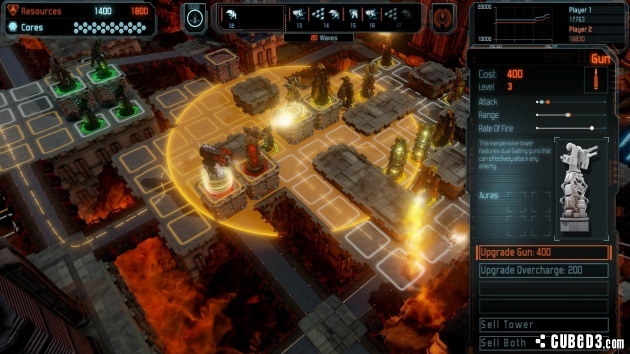Defense Grid 2 (PlayStation 4) Review
By Gareth F  30.01.2015
30.01.2015

It's fair to say that tower defence as a sub-genre is a fairly recent descendant of the real-time strategy genus, with humble origins that have evolved from Adobe Flash powered games lightweight enough to be played in an Internet browser. Digging a bit deeper, though, reveals that certain key elements of the genre have been in existence for some time, with the earliest prototype dating as far back as Atari's 1990 coin-op 'Rampart,' which involved defending a castle from an invading armada by maintaining a number of working cannons in set locations. A quarter of a century on and even big name franchises as diverse as Assassin's Creed and Gears of War have incorporated a tower defence component to augment what would be considered by some to be the very antithesis of a real-time strategy game. As if that wasn't unseemly enough, Plants vs. Zombies, the poster child for mainstream tower defence, has recently dipped its toe in the team-based shooter arena, with the excellent Plants vs. Zombies: Garden Warfare. However, for all the purists out there still wanting an undiluted shot of tower defence, it doesn't come any more straight edge than the Defense Grid series.
The critically acclaimed Defense Grid: The Awakening served as an introduction to the genre for a lot of people (this reviewer included), and it did brisk business on both the PC and Xbox 360. Five years on and Hidden Path has finally released a follow up with the slightly less imaginatively titled Defense Grid 2, which also marks a first for the series by debuting on Sony's console platform.
How does it fare when compared to its predecessor?
For those unfamiliar with the premise behind tower defence, the long established blueprint tasks the participant with protecting an item(s) from a persistent enemy intent on taking/destroying it via increasingly stronger waves. In the instance of Defense Grid 2, a reactor containing twenty four power cores is at risk from a seemingly never ending stream of robotic aliens intent on stealing the cores for undisclosed purposes.
Limited resources are available at the start of play, which can be spent on building static, weaponised towers at key points along the route the aliens are likeliest to take to the reactor, which will automatically lock on and open fire on the nearest potential kleptomaniac that just so happens to pass by. Available resources continuously increase as play progresses, giving the option of either building more towers to cover choke points/weak spots, or upgrade existing towers, which will temporarily disable them in the process, but is ultimately worth it for the increase in range and firepower.

Each alien variety has a unique set of traits to be taken into consideration when building fortifications, which would be problematic if there wasn't a tower with the required ability to counter them. For example, a faster moving enemy that would normally speed through weapon placements can be slowed down with a well-placed Temporal tower, ensuring sluggish movement as it remains within the effective radius. Likewise the larger, heavily shielded aliens normally impervious to bullets can be softened up with a Tesla tower, which chips away at the force field protecting them. Any aliens resilient enough to make it all the way through the defences to the reactor help themselves to a power core, turn around then head back in the direction from whence they came.
If lady luck is smiling down on the player then one of the tower turrets will take down the thieving invader on its way back to the exit, and the dropped power core will slowly make its own way back to the reactor...unless, of course, it gets intercepted by another alien intent on fulfilling its destiny. Should the player make it through all waves of the attack while retaining at least one power core, then it's deemed a success, but as the game progresses being tasked with more than one reactor to guard helps crank up the challenge. Nobody said it was going to be easy.

Fans of the first Defense Grid will be pleased to hear that, besides a noticeable visual buffing, Hidden Path has resisted the urge to tamper with the formula too much, though there are some new additions aimed at enhancing tower performance. The inclusion of a command shuttle enables the option to bring non-operational platforms for tower construction into play at the cost of a small amount of resources, and will definitely be of importance for increasing tower output at the higher difficulty levels. Further options to tweak the towers' effectiveness have been added, with the introduction of selectable loadouts, which modify weapon behaviour, as well as boost platforms, further elevating and, by default, increasing reach and scoring.
Should an unforeseen 'tower fail' occur and a number of power cores get perilously close to the exit, then the player can unleash an orbital weapon that slowly charges during play and can be deployed during an emergency. What type of orbital weaponry is available is entirely dependent on which member of the command team AI the player selects at the start of the round, but it goes without saying that some are more effective than others, so it's a case of choosing one to match the perceived needs of the level.
By including a number of challenge modes for each map Hidden Path has added a LOT of replay value to Defense Grid 2, so rather than play through the story the participant can instead opt to modify the challenge by tweaking a few variables. For example, limiting the number of towers available for construction will force a more frugal and tactical approach with the placements, while not allowing any turrets to hit the top tier of upgrades will similarly force a rethink of strategy going forward.

Anybody feeling the need for punishment can up the ante by selecting the 'Power outage' modifier, which ensures that towers will only open fire when the cursor is in close proximity - cue a frantic game of flitting around the map trying to cover all the hot spots at once. Unsurprisingly, 'Frozen power core' is exactly what it sounds like, as dropped cores no longer return to the reactor automatically, meaning anything dropped closer to the alien extraction point faces all the more likelihood of being snatched up. It is oddly relaxing to construct as many maxed out towers as possible, just to watch the ensuing carnage at double speed, having the option of selecting 'Grinder,' which is a hundred waves of core hungry aliens. Give it a go... It's strangely hypnotic.
Another first for the Defense Grid series is the addition of an online multiplayer component, which sees the introduction of both co-op and competitive game modes for the more sociable tower enthusiasts. While co-op is fairly self-explanatory, the competitive mode sees vanquished enemies fired to and from the opponent's defence grid, obviously increasing the strain on both participants' towers in the process - the objective, of course, is to totally drain the other player's cores.
It'd be fair to consider Defense Grid 2 as a niche title, which indirectly means there's a significantly smaller pool of online players to choose from in the matchmaking process. Nobody likes sitting in a lobby for ten minutes in the vain hope that some online opposition might turn up, so it's nice to see that Hidden Path has addressed this by enabling matchmaking in the background, allowing play to continue as normal until a suitable competitor is found. If only more sparsely populated online games employed this system. The inclusion of real-time updates comparing current score against that of friends who've previously played that level, along with end-of-round performance graph comparisons, also bring another level of competition into play.

Cubed3 Rating
Great - Silver Award

There's no denying that Defense Grid 2 is an absorbing experience, and its low barriers to entry ensure it should appeal to seasoned RTS vets and tower defence noobs alike. For lovers of the blueprint, it's really not that hard to see why this series has become synonymous with the genre, and that in itself should be recommendation enough.
Comments
Comments are currently disabled

 Sign In
Sign In Game Details
Game Details
 Out now
Out now  Out now
Out now  None
None  Out now
Out now  Subscribe to this topic
Subscribe to this topic Features
Features







 Top
Top

